If you want to run an online store without spending a lot of money, an open-source ecommerce platform is a great option. These platforms give you full control of your store. You can change how it looks, how it works, and even add your own features.
In this blog, we will explore the seven best free open-source ecommerce platforms. We will break down their real strengths and weaknesses based on how people actually use them, not just the features listed on their websites.
So, if you were searching for a bias-free blog that helps you find your ultimate free open-source ecommerce platform, you’re in the right place!
What is an Open Source Ecommerce Platform?
An open-source ecommerce platform is a type of software that you can download and use for free. The source code is open, so anyone can see it, change it, and customize it as needed.
These platforms usually don’t come with hosting or customer support, so you will need to set it up on your own server or with a hosting provider.
But the big advantage is ‘freedom’ – freedom to design, build, and scale your store your way. Below are the platforms we will be covering on our blog, here’s who they are best for –
- EasyCommerce is best for WordPress users who want speed and simplicity.
- PrestaShop is great for mid-size stores with global reach.
- OpenCart works well for small stores on a budget.
- Magento is powerful but needs advanced skills.
- WooCommerce is ideal for WordPress users who want plugin flexibility.
- VirtueMart is a decent option if you use Joomla.
- Drupal Commerce is good for developers building content-rich stores.
7 Best Free Open-Source Ecommerce Platforms
The internet is full of free, open-source ecommerce platforms, but not all of them are worth your time. Some are outdated, poorly supported, or too complex to use. So, how do you know which ones are actually trustworthy today?
Let’s explore seven of the most popular and reliable open-source platforms you can use to start your online store with confidence.
1. EasyCommerce
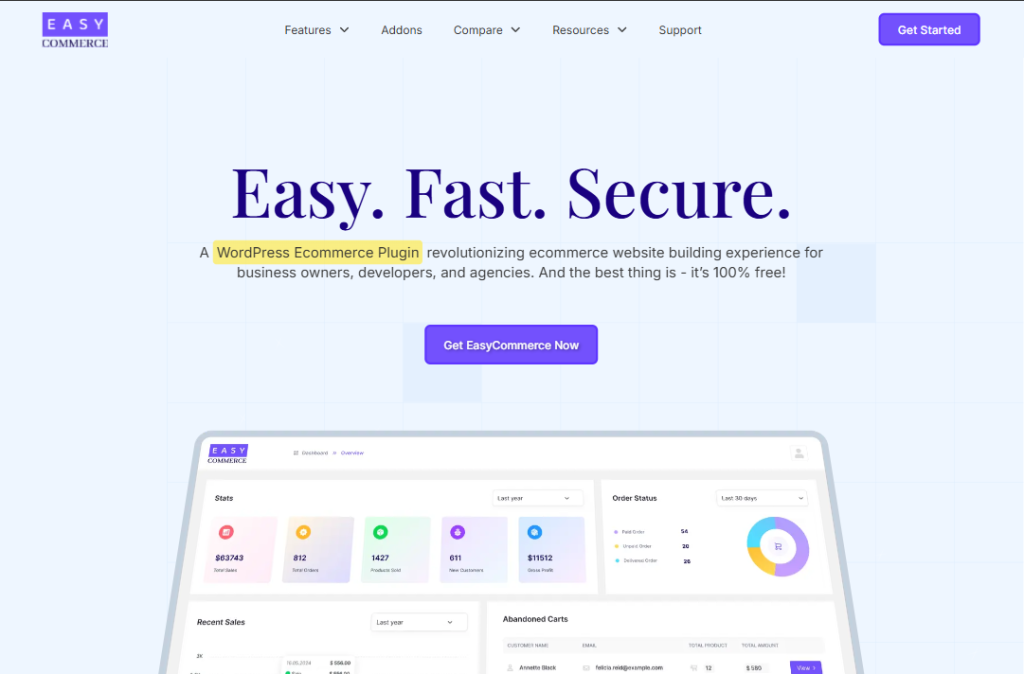
EasyCommerce is a fast, lightweight, and reliable ecommerce platform built for WordPress. It’s designed to solve the performance problems many users face with WooCommerce.
EasyCommerce stores all your product data in its own separate tables. Its API-fast build keeps your site fast, even with hundreds or thousands of products. You also get built-in features like coupons, digital product support, and email automation without needing extra plugins.
Many users say EasyCommerce is easier to manage because it has fewer dependencies and runs faster from the start. It’s ideal for anyone looking for a stable ecommerce plugin with modern features and better speed.
The best part? You’re getting the core EasyCommerce for absolutely free, except the domain-hosting-SSL associated cost.
Benefits of Using EasyCommerce
- Offers a cleaner interface and smoother experience than most traditional ecommerce tools.
- Comes with essential features like coupons, shipping options, abandoned cart recovery, and detailed reports without requiring any extra plugins.
- Includes a wide range of mostly free addons to connect with tools like CRMs, email marketing apps, and more.
- Supports all major payment gateways, making it easy to sell across regions and customer types.
- Makes product listing and inventory tracking simple and efficient.
- Has a 24/7 support team ready to assist you whenever needed.
- Let’s you customize product pages easily using the built-in Gutenberg editor.
- Regularly improved with new features and updates based on real user feedback.
Drawbacks of Using EasyCommerce
- Newer and still growing its community.
- Works only with WordPress.
2. PrestaShop

PrestaShop is another open-source ecommerce platform used by thousands of online stores around the world. It includes features like multi-language support, product management, and advanced pricing rules.
Many users choose PrestaShop for its flexibility. You can customize almost anything – from product layouts to shipping rules. There are thousands of free and paid modules to add new tools.
However, using PrestaShop requires time and patience, especially for newcomers during setup or updates. If you want better stability and easier maintenance, we recommend purchasing the PrestaShop Hosted plan.
Benefits of Using PrestaShop
- Great for international stores (multi-language and multi-currency).
- Active marketplace with many modules and themes.
- No extra plugins required to launch a full-featured store.
Drawbacks of PrestaShop
- Setup and configuration can be complex.
- Some features are locked behind paid modules.
- Needs regular maintenance and updates.
3. OpenCart
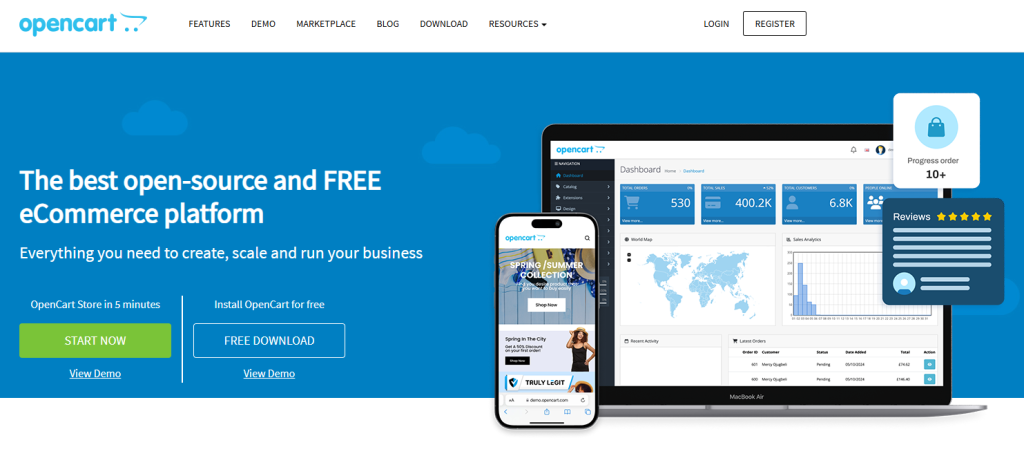
OpenCart is known for being lightweight and easy to run on low-cost hosting. Many small business owners pick OpenCart for its simple admin panel and low server requirements. OpenCart was one of the earliest dedicated ecommerce platforms to gain popularity. At its peak, it became the third most-used solution worldwide, just behind WooCommerce and Magento.
It supports product reviews, multi-store setups, and built-in shipping/payment options. Real users say OpenCart works well for stores with up to a few hundred products.
However, customization can be tricky without coding knowledge. Some users also face issues when installing multiple third-party extensions together. Other than that, its a commendable free open source ecommerce platform even today.
Benefits of Using OpenCart
- Runs well on budget hosting plans.
- Simple admin interface for product and order management.
- No extra tools needed to start selling.
Drawbacks of OpenCart
- Customizing features requires developer help.
- Notable criticism for alleged weak security.
- Some extensions can cause conflicts.
4. Magento Open Source
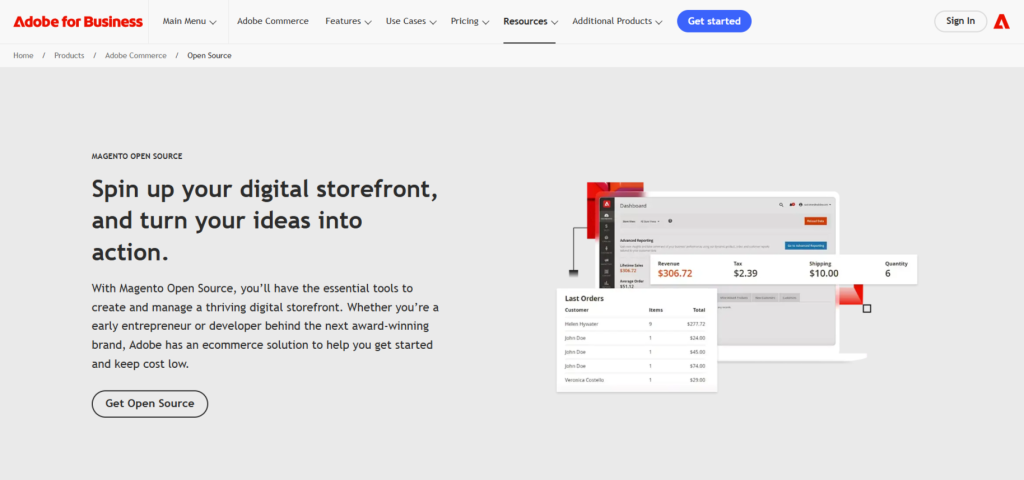
Magento is a professional-grade ecommerce platform. Its open-source version is free and includes tools for inventory management, custom pricing, and advanced marketing rules. After Adobe acquired Magento in 2018, its enterprise version was rebranded as Adobe Commerce.
It’s largely used by enterprises and developers who need full control and effortless scalability. You can manage thousands of products and customize almost every part of the site.
However, it’s resource-heavy and often needs a developer to manage or upgrade properly.
Benefits of Using Magento
- Enterprise features for free.
- Scales well for large product catalogs.
- Highly customizable with developer support.
Drawbacks of Magento
- Requires strong hosting and server setup.
- Very complex to install and maintain.
- Not ideal for beginners or small stores.
5. WooCommerce

WooCommerce is one of the leading WordPress plugins developed entirely dedicated to ecommerce. It’s one of the most popular tools in the world, with millions of active stores.
People love WooCommerce because it works well with other WordPress themes and plugins. You can add features like memberships, digital downloads, and subscriptions with third-party tools.
However, WooCommerce becomes slower with larger catalogs. It also needs a lot of plugins to add basic features, which can make things harder to manage. Not to mention the added costs for purchasing advanced addons/plugins for features that EasyCommerce offers by default or for free.
Benefits of Using WooCommerce
- Large library of themes and extensions.
- Active support community and tutorials.
- Easy for existing WordPress users.
Drawbacks of WooCommerce
- Performance issues with large stores.
- Needs multiple plugins for full features.
- It can become overwhelming to manage over time.
6. Joomla + VirtueMart
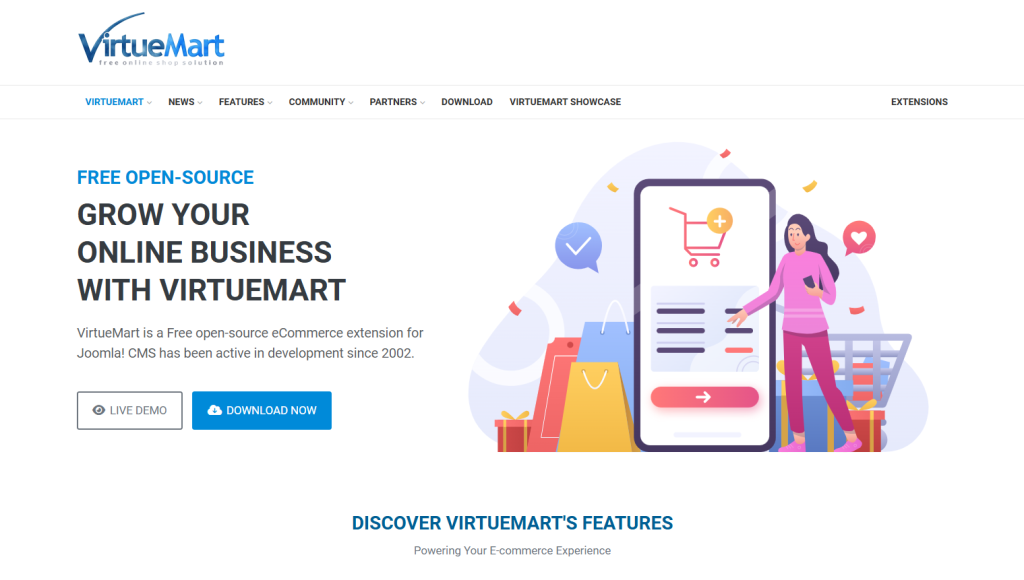
VirtueMart is an open-source and free ecommerce extension for the Joomla CMS. It allows you to create a shop on top of an existing Joomla site. While not as popular today, it still has a loyal user base.
It includes basic ecommerce features like product catalogs, shopping cart, checkout process to more advanced ones like multi-currency, custom fields & product variants, group pricing, etc.
Altogether, Joomla + VirtueMart is a reliable option for small to medium stores, especially if they already use Joomla. However, Joomla and VirtueMart are not updated as frequently as other platforms. This can limit your options if you want modern designs or features.
Benefits of Using Joomla + VirtueMart
- Works well for Joomla fans.
- Supports physical and digital product sales.
- Simple for small-scale stores.
Drawbacks of Joomla + VirtueMart
- Smaller community and fewer resources.
- Fewer modern features and themes.
- Limited compatibility with newer tools.
7. Drupal Commerce
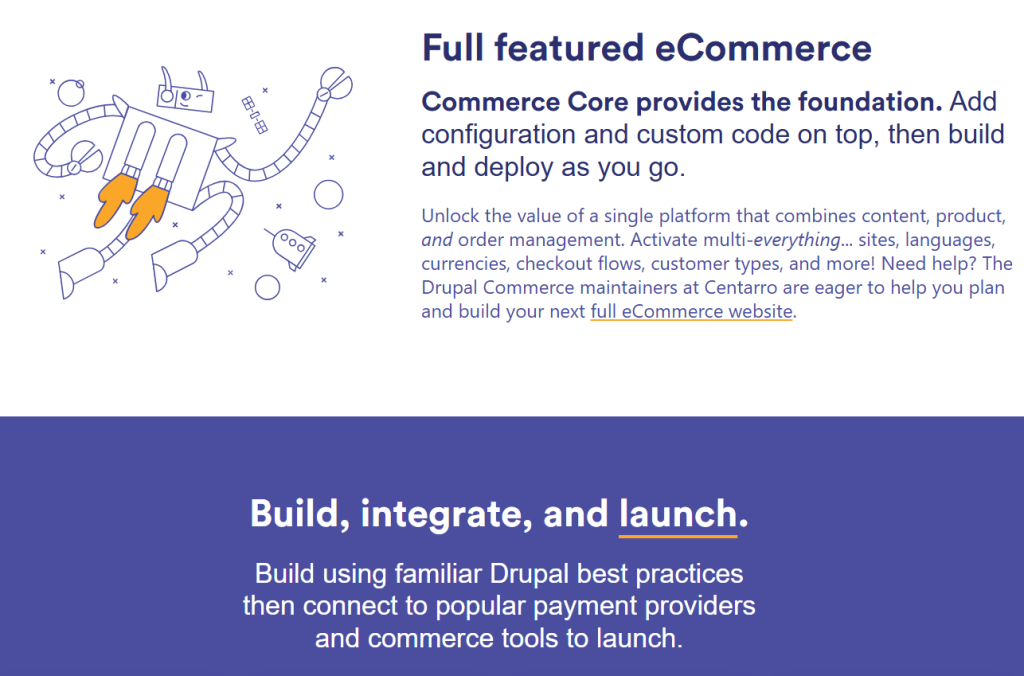
Drupal is a powerful content management system, much like WordPress. It’s best known for building websites with a lot of pages, user roles, and advanced permissions. You can sell physical or digital products, manage carts and checkouts, and even set up taxes and shipping options.
One of the best things about Drupal Commerce is its flexibility. You’re not limited to a fixed store layout or checkout process. With the right skill, everything can be customized, extended, or restructured.
Benefits of Using Drupal Commerce
- 100% free and open-source
- Strong for content-rich ecommerce sites
- Very flexible and customizable
- Large community and professional support available
- Good for advanced user roles and permissions
Drawbacks of Drupal Commerce
- Steep learning curve for beginners
- Requires more time to set up than WooCommerce
- Fewer ready-made themes and plugins compared to WordPress
- Not ideal for small or simple online stores
What to Look for in a Free Open-Source Ecommerce Platform

When choosing an ecommerce platform, here are a few things to check:
- Ease of Use: As a businessman, you won’t like to spend hours managing your website. That’s why you choose a platform where managing products, orders, and customers is easy and fun.
- Hosting Needs: Make sure your hosting meets the platform’s requirements, as poor performance can slow down your business growth.
- Community and Support: Open-source platforms are mostly managed by the community members. So, the bigger the community, the higher the chance of getting your problems solved.
- Extensions and Plugins: Your chosen open-source ecommerce platform should offer a rich library of plugins and addons to meet your needs.
- Performance: When running a business, performance and security are always non-negotiable.
It’s not all about just features when choosing an ecommerce platform. Consider the daily time and effort needed to manage your store.
Final Verdict
Open-source ecommerce platforms have become a popular choice for small to medium-sized businesses, especially those working with a limited budget and specific needs. The best part? Most of these platforms are completely free to use.
These platforms can be from both in and outside the WordPress ecosystem. The key is to pick the one that fits your business goals, technical skills, and future plans.
If you’re looking for a platform that’s fast, doesn’t slow down as your store grows, and includes everything in one place, EasyCommerce is worth a look. It’s a newer alternative to WooCommerce, designed to run smoother and perform better right from the start.
Frequently Asked Questions (FAQs)
1. What is the difference between open-source and hosted ecommerce platforms?
Open-source platforms give you full control over your store’s features, code, and hosting. You install them on your own server. Hosted platforms (like Shopify or Wix) manage everything for you, but they often charge monthly fees and limits customization.
2. Is it really free to use an open-source ecommerce platform?
Yes, the software itself is free to download and use. But you’ll still need to pay for things like web hosting, domain name, SSL certificate, and optional themes or extensions.
3. Which open-source platform is best for beginners?
Platforms like EasyCommerce and OpenCart are simpler and more beginner-friendly. They require less setup time and fewer technical skills compared to options like Magento or Drupal Commerce.
4. Can I switch platforms later if I outgrow one?
Yes, but it can take time and effort. You’ll need to migrate your product data, customer records, and design. That’s why it’s good to choose a platform that can grow with your business from the start.
5. Do I need to know how to code to use an open-source ecommerce platform?
Not always. Some platforms like EasyCommerce or WooCommerce let you run a store with little to no coding. Others, like Magento or Drupal Commerce, work best if you (or someone on your team) have development skills.

